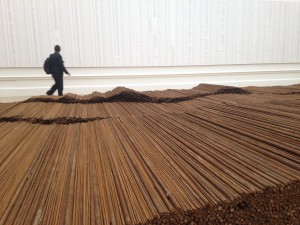There are two epicentres under consideration in this monumental installation at the Royal Academy right now. One was in Wenchuan County in Sechuan; the other is the government in Beijing.
The first meant a quake that destroyed 20 schools. The second has monitored the ongoing work of China’s best known artist and kept him at arm’s length with bureaucracy and doublespeak.
Ai contends that given their location on a seismic faultline, the schools should have been better built. This piece is a memorial, which lays square blame with corrupt officials and construction firms.
There is even something unpatriotic about substandard architecture. This, after all, is a nation most famed for a wall stretching more than 20,000km. It inspires a memorable short story by Kafka.
For the Great Wall, says the Czech writer (although how would he know?): “An unremitting sense of personal responsibility in the builders were indispensable prerequisites for the workâ€.
But you can see, from 200 tonnes of straightened rebar, the materials in Sechuan were not equal to the task. And as you can see from the accompanying film, the steel bars failed as a structure.
Now another wall was put up to protect the guilty. Ai’s team struggled to get information on the missing and the dead. “What if you’re an American spy?†asks a drudge on the end of the phone.
Until the major earthquake, Ai appears to have been something of a favoured son and a successful architect in his own right. As you know, he collaborated on the main stadium for the Beijing Olympics.
But it’s commonly thought that it is his unambiguous art of protest, and not his tax affairs, which led to his detention without trial for 80 days in 2011. The authorities have said little.
Kafka again, in character as a native of the old empire, “We Chinese possess certain folk and political institutions that are unique in their clarity, others again unique in their obscurity.â€
Clarity: Ai has crossed the line. Obscurity: we cannot tell you what line or where. Both qualities pursued the artist even to the point of his visa complications in getting to London for his show.
It is of course counterproductive. The repression gives additional power to the work. As if the walls filled with a list of 5,000 victims’ names, a list of serene despair, were not power enough.
Ai Weiwei at the Royal Academy can be seen until 13 December 2015. You can find my review for Culture24 here. The Kafka story mentioned is of course The Great Wall of China, to be found in the Complete Short Stories of Franz Kafka, Vintage, 1999.

One thought on “Ai Weiwei, Straight (2008-12)”